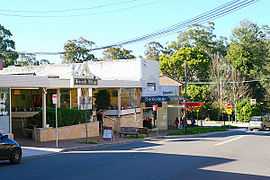Beecroft, New South Wales
| Beecroft Sydney, | |||||||||||||
|---|---|---|---|---|---|---|---|---|---|---|---|---|---|
|
Beecroft Village retail centre, Hannah Street | |||||||||||||
| Population | 8,836 (2011 census)[1] | ||||||||||||
| Postcode(s) | 2119 | ||||||||||||
| Location | 22 km (14 mi) north-west of Sydney CBD | ||||||||||||
| LGA(s) | Hornsby Shire | ||||||||||||
| State electorate(s) | Epping | ||||||||||||
| Federal Division(s) | Berowra | ||||||||||||
| |||||||||||||
Beecroft is a suburb of northern Sydney, in the state of New South Wales, Australia 22 kilometres north-west of the Sydney central business district in the local government area of Hornsby Shire. Beecroft is considered to be in the Northern Suburbs of Sydney.[2]
History
Beecroft was orchard country before its suburban development. The railway arrived in 1886 and Sir Henry Copeland, Minister of Lands, conducted a survey of the area to determine its suitability as a residential area. He named the suburb after the maiden name of his two wives, Hannah and Mary Beecroft, (two sisters he married in succession). Their names are also remembered through the respective naming of the suburb's east-west streets; Hannah Street, Copeland Road and Mary Street. Beecroft Post Office opened on 10 February 1890.[3] Due to the strength of the temperance movement in Beecroft at that time there have never been any hotels in Beecroft. The bushland and amenity of Beecroft has been largely preserved due to the efforts of the Beecroft Cheltenham Civic Trust which has been very active since its inception in 1958.[4]
Commercial area
The majority of commercial activity conducted in Beecroft is concentrated within a couple of blocks. Although not large by Sydney standards, it is nonetheless important in servicing the suburb and its immediate area, including parts of Cheltenham. The commercial area is located between Beecroft Road and Beecroft railway station. In keeping with the spirit of the traditional heritage, Old English is used throughout as the typeset of the Beecroft Village arcade. Hannah Street, the suburb's main commercial street, underwent a significant beautification upgrade in 2005.
Transport

Beecroft railway station is on the North Shore, Northern & Western Line of the Sydney Trains network. In addition to passenger railway traffic, the Main Northern Line also acts as an intercity and freight train thoroughfare passing through Beecroft. Beecroft is also serviced by various bus routes including route 553 from Sydney Buses and routes 651 and 635 from Hillsbus.
Prior to the construction of the M2 Hills Motorway, Beecroft's main road thoroughfare was commissioned as part of Sydney's Metroad system of major arterial roads and throughways. Beecroft Road was part of the Metroad 2 thoroughfare which took motorists between Sydney's Central Business District and Windsor via the Sydney Harbour Bridge, Epping and Castle Hill.
Churches
The Anglican church - formerly the Church of England - was especially prominent in Beecroft society. The suburb itself has three churches within its boundaries; St. John's Anglican (Church of England) Church and Beecroft Uniting Church on Beecroft Road, with Beecroft Presbyterian Church on Mary Street, opposite the school.
Education
Beecroft has three Primary Schools, an independent Anglican school and a high school on the border of Carlingford:
- Beecroft Primary School - established in 1897
- Roselea Public School
- St. Gerard Majella Catholic Primary School
- Arden Anglican School
- Carlingford High School
Sport and recreation

Beecroft is also bestowed with a number of recreational facilities within its boundaries. Beecroft is home to Pennant Hills Golf Club, as well as a lawn bowls club near the school, a lawn tennis club, as well as general park space at the Village Green, walking trails through Chilworth Reserve and other forested areas.
Birdlife
The central bushlands are known for the presence of the satin bowerbird, and many blue objects such as milk bottle tops and clothes pegs from nearby homes can be found in their nests. Other bird species found in the local bush include the kookaburra, yellow-tailed black cockatoo, galah, corella, sulphur-crested cockatoo, rainbow lorikeet, whipbird, king parrot, eastern and crimson rosella, bush turkey, butcher bird, crested pigeon, powerful owl, magpie and currawong.

Population
According to the 2011 census of Population, there were 8,836 residents in Beecroft. 69.0% of residents were born in Australia. The most common other countries of birth were England 3.6%, China 2.9% and Hong Kong 2.8%. 76.3% of residents spoke only English at home. Other languages spoken at home included Cantonese 6.4%, Mandarin 3.2% and Korean 2.1%. The most common responses for religious affiliation were Catholic 24.0%, No Religion 22.0% and Anglican 20.6%.[5]
Notable residents
- Sir Garfield Barwick, Australian High Court Justice
- Meredith Burgmann, politician
- Ruth Cracknell, actress
- Anh Do, comedian
- Steve Glasson, bowls player
- Neil Rawle, sound engineer[6][7]
- Leslie Alfred Redgrave, writer, grazier and headmaster, lived from 1923 until 1943 at Bellingara, 109 Copeland Road[8]
- George Sargent, Australian meat pie businessman
Coordinates: 33°45′06″S 151°03′48″E / 33.7518°S 151.0633°E
References
- ↑ Australian Bureau of Statistics (31 October 2012). "Beecroft (State Suburb)". 2011 Census QuickStats. Retrieved 5 November 2012.
- ↑ "Postcodes Australia - Qpzm". qpzm.com.au.
- ↑ Premier Postal History. "Post Office List". Retrieved 1 June 2012.
- ↑ Beecroft and Cheltenham, The Shaping of a Sydney Community to 1914 (Beecroft Cheltenham History Group Inc, 1995). ISBN 0-646-24286-5
- ↑ Australian Bureau of Statistics (31 October 2012). "Beecroft (State Suburb)". 2011 Census QuickStats. Retrieved 29 April 2013.
- ↑ Craig Mathieson (15 July 2011). "Going for the record". The Sydney Morning Herald. Retrieved 25 April 2014.
- ↑ "Neil Rawle". Neil Rawle on Discogs. Discogs. 2014. Retrieved 25 April 2014.
- ↑ Beecroft Cheltenham Civic Trust – 109 Copeland Road Retrieved 30 April 2014
| Wikimedia Commons has media related to Beecroft, New South Wales. |
